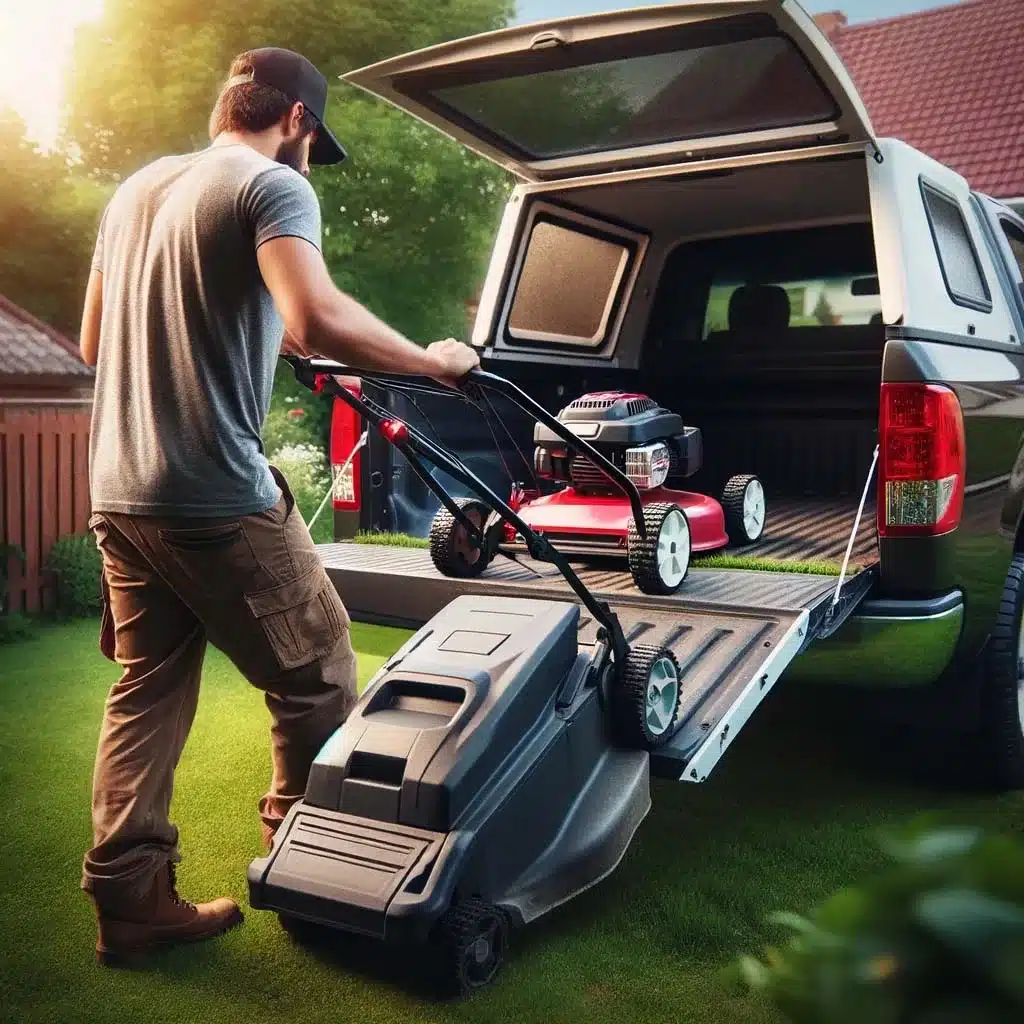
Ready for moving day? Did you forget about how to move the lawn mower?
It may be common to focus on the ‘inside’ stuff while packing for your move. But don’t forget, all the tools and forgotten junk in your shed also needs to go, to make way for the new inhabitants of the home you’re leaving.
If you have a yard to maintain on your current home, and will have one in your next home, you’ll probably want to bring the lawn mower with you. No need to waste that investment!
But hang on: you don’t want a stinky, dirty, gas-filled, spark-ready lawn mower packed up next to your clean couch, and rolling around in the moving truck. Yikes! So, follow these tips below to move your lawn mower like a pro mover (or to prep for the pro movers when they arrive!).
Before you move a lawn mower, empty its gas and unplug its flame-inducing parts.
Professional movers will not take gasoline in their moving truck. No matter how much you beg, and no matter how small it may seem. It’s a safety hazard, and so, it’s a no-go. If you want your lawn mower to go in that moving truck, you’ll need to empty the gas. And, unplug the spark plug, so no fires happen in the moving truck, please.
So what do you with all that gas you paid top dollar for? You can either use it up by mowing your lawn before moving day. Or you can put it in a fancy made-for-gas container (you know the ones with the spout, and the twist seal, with the handle). You can put it in your own car to take on a short-distance move. Or, you can dispose of it according to your local city bylaw regulations.
But please…don’t just leave gas in a bucket in your hard…especially not in dry, hot summer.
Of course, if your lawn mower does not use gas, you can skip this step.
If your lawn mower is electric, be sure to read your product manual (or google it online), to find out if there are safety precautions to take before transporting it.
Clean your lawn mower before moving, and do some maintenance on it while you’re at it.
Your lawn mower is probably full of dirt and grass in places you didn’t think dirt and grass could exist. Ok, maybe you did think it. Either way, you don’t want to end up with grass stains on your stuff, while it’s all crammed in a moving truck. So it’s time for clean up.
If your lawn mower has a bag attachment to collect grass clippings, give that a good ol’ shake-out. Then, hose it down. Or, if you have one of those pressure washers that can turbo-speed soapy water on things, maybe try that. We take no liability for the effects of this trick though.
For the rest of the lawn mower parts, the general consensus on the Internet is to give it a good brushing and a hose-down with a strong pressure hose attachment.
What to do with all the guck that comes out? Maybe compost? Check out our article on how to move a compost here.
While you’re making your lawn mower clean as new, you can also get on some maintenance, to keep it alive and well for your new life at your new home. Angie’s list has a blog post on how to do this:
https://www.angieslist.com/articles/8-maintenance-tips-keep-your-lawn-mower-running.htm
And yes, there are probably people you can hire to do this.
See related on our blog: How to find home services online after a long distance move
Find a safe solution for lawn mower blades before you pack them for moving.
If you’re lazy, and you want to duck tape your lawn mower blades before moving, or if you want to detach them and carefully bubble wrap them, either way, you need a solution for this.
If you’re not comfortable handling the blades of your lawn mower, be sure to ask your moving company if they can include this in their service when they give you a moving quote. As before moving day! If this ends up costing extra, don’t be surprised. And, if they say no, also don’t be surprised. Movers need to be protected by insurance for injuries, such as by WorkSafeBC. So generally, they shouldn’t be going outside the scope of ‘normal’ when it comes to moving hazards.
But no, open, exposed and dangerously sharp objects can’t just be piled into a moving truck. And you wouldn’t want them banging around loosely in a box either.
If your blades are dull and need replacing or sharpening, maybe now is a good time to do that. Again – safely! See if a metal pick-up company will come get them for you. Though, they’d probably want the trip to be more worth their while, so collect other scrap metal for them too. If you hire a junk removal company before moving day, ask in advance if they can handle the mower blades (some may even help you disassemble them).
If you take blades with you, label your box, so that people know there are sharp items in there. Cardboard is not recommended here, as it can rip easily. Try plastic.
Stop the wheels from rolling around in the moving truck.
You don’t want the lawn mower rolling in the truck. Remember – it’s got wheels! Find a way to stop the wheels from rolling. You can do this by packing heavy items in front, and behind the mower. Or you can use a wheel stopper.
Remember: not all lawn mowers are created equal, even when it comes to moving them.
Lawn mowers may or may not be worth the move, depending how big of a move you’re making, or the value of your lawn mower. And sometimes, the tips we’ve mentioned above may not apply, depending on the lawn mower you are moving. If you have a ride-on lawn mower, for example, then you’ll need a ramp, or some other method to tow it to your new destination (on a short-distance move).
The other ‘treatment’ you can give your lawn mower before moving is to sell it with classified listings. Then, buy another one when you arrive at your new destination.
Here is an article that explains types of lawn mowers you can pick for different types of yards: https://www.popularmechanics.com/home/tools/reviews/g867/how-to-pick-the-right-mower-for-your-lawn/
See related posts:

Categories
Moving Resources
Moving Checklist
Follow this comprehensive moving checklist to ease your relocation stress and stay organized.
Learn MoreMoving Company Comparison Guide
This comparison guide helps you evaluate and select the perfect moving company for your needs.
Learn MoreWe make moves easy for you.
- Local Moving
- Long Distance Moving
- Seniors Moving
- Piano Moving
- Item Relocation
- Overnight and Long-term Storage
- Packing Supplies

